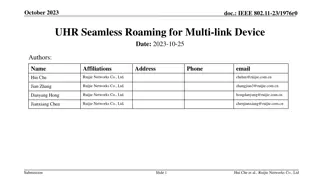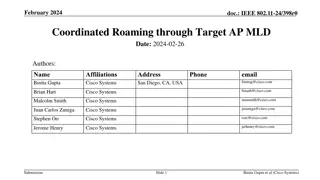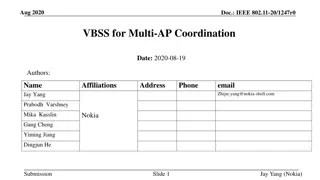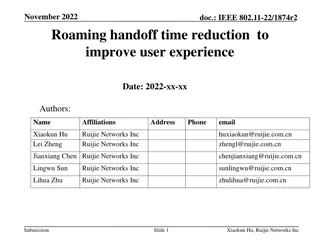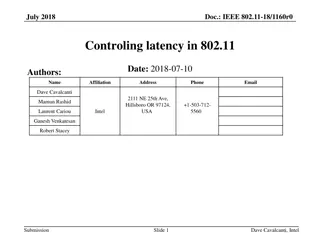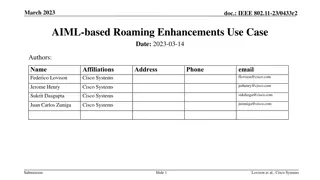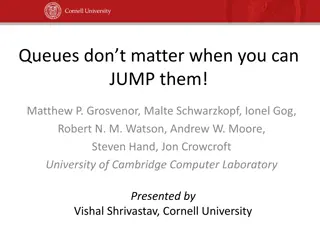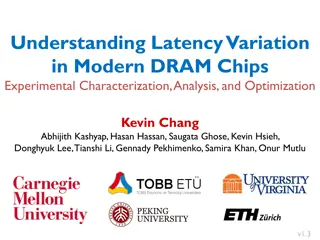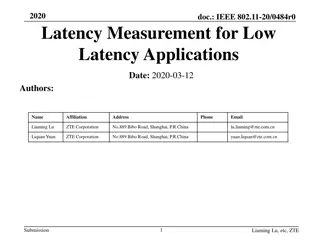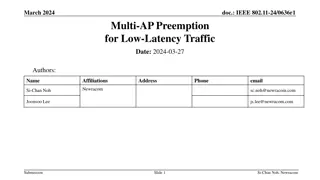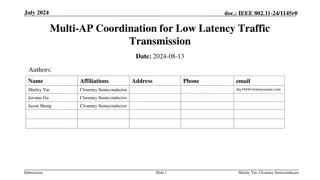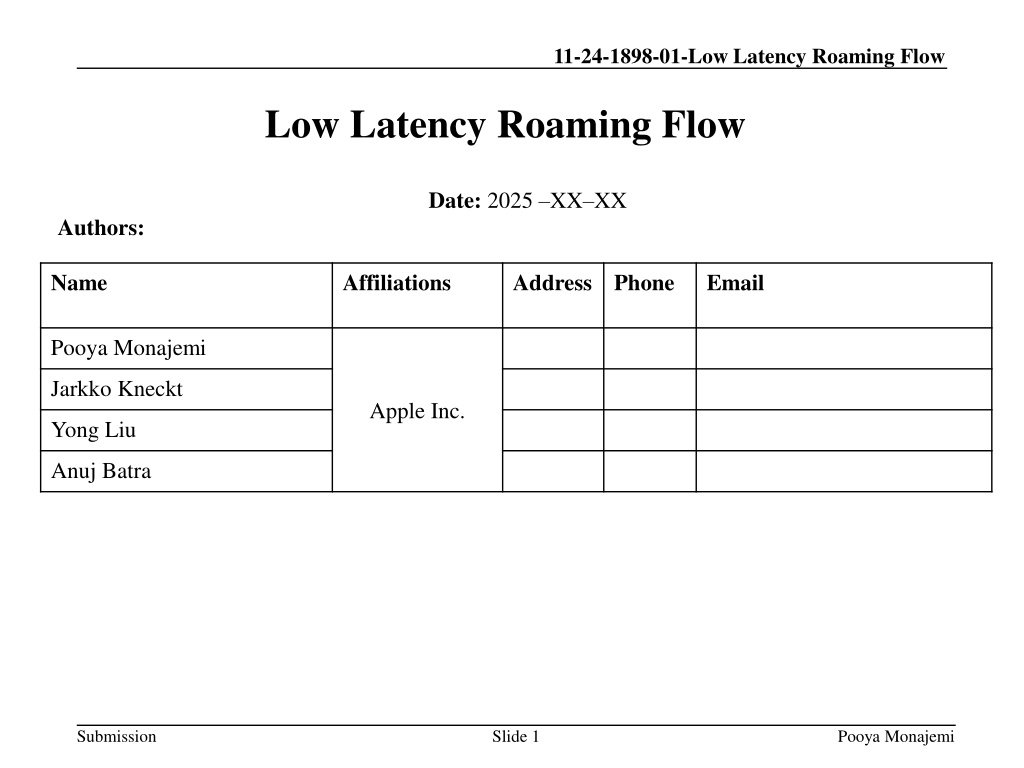
Understanding Low Latency Roaming Flow Mechanisms
Explore the intricacies of low latency roaming flow mechanisms in wireless networks, focusing on loss-less transition and minimizing latency during downlink operations. Learn about data path switching, window motion, and contiguous SN operation groups for seamless roaming experiences.
Download Presentation

Please find below an Image/Link to download the presentation.
The content on the website is provided AS IS for your information and personal use only. It may not be sold, licensed, or shared on other websites without obtaining consent from the author. If you encounter any issues during the download, it is possible that the publisher has removed the file from their server.
You are allowed to download the files provided on this website for personal or commercial use, subject to the condition that they are used lawfully. All files are the property of their respective owners.
The content on the website is provided AS IS for your information and personal use only. It may not be sold, licensed, or shared on other websites without obtaining consent from the author.
E N D
Presentation Transcript
11-24-1898-01-Low Latency Roaming Flow Low Latency Roaming Flow Date: 2025 XX XX Authors: Name Affiliations Address Phone Email Pooya Monajemi Jarkko Kneckt Apple Inc. Yong Liu Anuj Batra Submission Slide 1 Pooya Monajemi
11-24-1898-01-Low Latency Roaming Flow Background - Roaming Process Basic data path switch mechanism: The STA switches data path to the target AP MLD (AP MLD2) to send new uplink frames and receive new downlink frames Meanwhile there may still be some downlink frames sitting on the origin AP MLD (AP MLD1) STA is allowed to continue to retrieve these buffered DL frames from AP MLD1 In case of data transfer capability in network, we expect the STA to disable all links with AP1 and retrieve both the buffered DL as well as the new DL from AP2. Our objectives, focusing on downlink operation: Loss-less transition Minimizing latency Submission Slide 2 Pooya Monajemi
11-24-1898-01-Low Latency Roaming Flow Background: Contiguous SN Operation Group is considering DL operation using a common SN space, with potential to support concurrent DL Option to reset the SN numbers at the target AP is also available In this mechanism, an SN gap is assigned by AP1 to allow for further DL frames from the DS until DS mapping is updated During the transition period: Window moves forward due to AP1 transmissions, and AP2 does not have the latest updated window information Any DL MPDUs received by AP2 with SN>Win_End_R need to be buffered until window moves forward Submission Slide 3 Pooya Monajemi
11-24-1898-01-Low Latency Roaming Flow BA Window Motion As DL frames are transmitted by AP1, the BA window should shift per baseline This new window information does not get updated at AP2, at least not immediately AP2 remains on the BA window that was synchronized at the time of roam initiation We do not need to update the window after each DL transmission by AP1, but at least once when all AP1 buffers are empty The window should not be moved to after the SN gap because of AP2 DL transmissions during the transition period E.g. a BAR from AP2 should not move the STA s window when transition is happening Submission Slide 4 Pooya Monajemi
11-24-1898-01-Low Latency Roaming Flow SN Space Challenges Concurrency will only occur if we can have a large enough buffer to handle potential downlink transmissions before DS mapping update With a smaller BA window, a burst of DL frames during the roam can overrun the SSN assigned to AP2 during context transfer Cost of implementing larger RRB buffers Larger buffers cost in terms of memory and are not always ideal Submission Slide 5 Pooya Monajemi
11-24-1898-01-Low Latency Roaming Flow SN Overlap Issue Arrival of too many DL frames from the DS can cause the AP1 SN space to run out and overlap with the pre-assigned AP2 SN space This will cause loss of DL data Assignment of AP2 SSN values is out of the control of the STA In a smaller window case, forcing concurrent operation will increase the likelihood of SN overlap and DL loss Submission Slide 6 Pooya Monajemi
11-24-1898-01-Low Latency Roaming Flow Case for Sequential Retrieval Sequential DL retrieval: First empty AP1 buffer then start new downlink from AP2 Reasons for choosing sequential DL retrieval: New DL data from AP2 cannot be forwarded to the stack in order until older data on AP1 is received first. Little gain in receiving new data earlier. When AP1 link is fading, avoiding DL loss means prioritizing the reception of buffered DL frames from AP1 before receiving new DL frames from AP2 (no data transfer assumed) Placing radio resources on AP2 link takes away from chances for AP1 to complete this transmission as quickly as possible Smaller BA window size can leave a very limited or no space of SN numbers for target AP Goal: Need to provide the sequential DL retrieval as an option for the STA SN Reset: When receiving sequentially, there is no need for continuity of SNs. STA can request a DL SN reset at the target AP to simplify operations This avoids any overlap and SN space shortage issues It also eliminates need for SN sync between APs The target AP also does not need to wait for completion from AP1 before moving the BA windows forward Submission Slide 7 Pooya Monajemi
11-24-1898-01-Low Latency Roaming Flow Origin AP Notification We need signaling that notifies the STA of the DL buffer status on the origin AP Notification of completion of buffered DL delivery at the origin AP is required: In sequential mode: to allow any new DL from the target AP In continuous SN mode: To move the BA windows forward on the target AP and allow further transmissions past the original window boundaries In both modes: To allow the STA to remove radio resources from links with origin AP and enable all links with target AP Relying only on a timer-based solution is a poor choice: a timer will either be too short and results in loss of data, or will be too long and results in latency (preventing further transmissions until the timer expires) Need to define a method for the target AP to start transmitting DL This may simply be a STA coming out of PS, or any other means Size of buffered DL data can help the STA in optimizing operation mode E.g. STA may allocate more/better links to origin AP if larger DL amount buffered E.g. STA may choose to forfeit DL on origin if emptying buffer is deemed unattainable Submission Slide 8 Pooya Monajemi
11-24-1898-01-Low Latency Roaming Flow Need for STA-Initiated DL Continuation We need a method for the STA to indicate to the second AP that STA wants to receive new DL. In case of SN reset: Any new DL. In case of continuous SN: new DL beyond the original window. Use case 1: Link with the first AP might be disappearing very quickly, or already lost Use case 2: STA has no interest in receiving the buffered DL, prefers to receive newer DL Use case 3: Data for one TID is latency-sensitive and STA wants to move to AP2 as soon as possible Submission Slide 9 Pooya Monajemi
11-24-1898-01-Low Latency Roaming Flow STA-Managed Sequential Retrieval AP2 does not transmit DL data until STA explicitly requests continuation of DL data STA may choose to initiate this operation quickly (and discard AP1 data), or wait for a notification from AP1 that data is drained (below) Meanwhile STA may transmit UL to AP2 but consider in PS in this duration STA receives notification of completion of data on AP1 side This may simply be a properly-set More Data bit, or any other signal. STA signals readiness to receive new data from AP2 The explicit signal may be STA coming out of PS on AP2 link (in sequential case), or another signal Note: This can be useful if STA wants to receive new DL and/or loses link with AP1 Note 2: This assumes no further coordination between APs about the AP1 buffer state. This can reduce latency in case of slow AP-to-AP sync. Note 3: In continuous-SN mode, the same signal can be interpreted as readiness to move the BA window beyond the end of AP1 s SN space for all TIDs AP2 Starts DL transmissions With DL SN reset, AP2 does not need to take into account state of AP1 s buffers or STA s DL RRB Submission Slide 10 Pooya Monajemi
11-24-1898-01-Low Latency Roaming Flow Conclusions We discussed various issues in downlink during roaming transition: RRB window sync SSN assignment complexities, including BA window size limitations and overlap issues Sequential retrieval option Origin AP buffer state notification requirement Handling of DL in a contiguous SN space is a challenge, especially for shorter BA windows. We believe using sequential retrieval combined with SN reset is straight forward and least error prone with negligible performance impact. There is need for an empty DL buffer indication from the origin AP This allows the STA to fully relinquish links with the origin AP and focus all resources on the target AP (applicable to both sequential and concurrent DL modes) In sequential DL retrieval this allows the STA to start receiving new DL from the target AP Additionally, DL buffer depth indications can help the STA with resource allocation and decision making Proposed STA-side signaling approach to manage sequential retrieval Origin AP indicates completion of DL STA explicitly requests continuation of DL from the target AP (potentially before origin AP notification) Submission Slide 11 Pooya Monajemi
11-24-1898-01-Low Latency Roaming Flow SP1 Do you support that during a roaming transition, the current AP MLD shall be capable of signaling termination of downlink data transmission to the non-AP MLD before the transient period ends? NOTE: AP sends the indication when there is no more pending DL data (all TIDs). TBD other conditions Signaling TBD Submission Slide 12 Pooya Monajemi
11-24-1898-01-Low Latency Roaming Flow SP2 Do you support that in the seamless roaming procedure, non-AP MLD can request not to transfer from the current AP MLD to the target AP MLD any of the following as part of the context transfer? the next SN for existing DL BA agreements of all TIDs the latest SN that has been passed up for existing UL BA agreements of all TIDs Submission Slide 13 Pooya Monajemi
11-24-1898-01-Low Latency Roaming Flow SP3 Do you support that during a roaming transition, the origin AP should report the status of the downlink buffers to the STA ? TBD if reported per AC or TID Signaling TBD Submission Slide 14 Pooya Monajemi
11-24-1898-01-Low Latency Roaming Flow SP4 Do you support that during a roaming transition, a STA may request the target AP MLD to start sending downlink data for a set of TIDs? Signaling TBD Note: Before target AP MLD starts sending downlink Data for the set of TIDs, STA may receive data for that set of TIDs from the origin AP MLD Note: Data for TIDs that have not been requested will be buffered, pending a future request Submission Slide 15 Pooya Monajemi
11-24-1898-01-Low Latency Roaming Flow BACKUP Submission Slide 16 Pooya Monajemi
11-24-1898-01-Low Latency Roaming Flow Stuck TID Issue Issue: data for one TID cannot advance until data for all other TIDs is fully received. Results in latency. This issue can occur if there is only one notification of buffer empty from the origin AP In concurrent mode: STA receives enough data from both APs to fill the window The window cannot move forward until we receive notification that the data from AP1 buffer is complete Stuck TID in Concurrent DL In sequential mode: STA waits to empty all AP1 buffer Data for AC_VO cannot advance until AC_BE data is also complete A Per-TID sequential operation is needed: For each TID data is received from the origin AP first before receiving new data from the target AP for the same TID. Concurrency DL reception can occur for data of different TIDs Stuck TID in Sequential DL Submission Slide 17 Pooya Monajemi
11-24-1898-01-Low Latency Roaming Flow AP-Managed Sequential Retrieval Assumption: STA maintains an active link with each AP after roam exchange. At the time of initiating the roam, STA requests a per TID sequential operation AP2 does not transmit DL data for a TID until AP1 has no further buffered DL data for that TID APs sync the buffer status in the background (no STA involvement) When AP2 receives notification of completion of data for a TID from AP1, AP2 can either: Send new DL belonging to this TID to the STA AP2 can use the BAR frame Both of the above methods inform the STA that all data from the old AP for this TID is complete, move the window forward Signaling the completion can be done either by announcing AP2 SSNs to the STA at the time of roam init, or by using explicit signaling in BAR frame (assign one of the reserved bits) A variation of this method is to combine the notifications for all TIDs With the risk of the stuck TID issue Submission Slide 18 Pooya Monajemi
11-24-1898-01-Low Latency Roaming Flow STA-Managed Sequential Retrieval (Per TID) At the time of initiating the roam, STA requests AP2 to wait for STA explicit signal to transmit each TID AP2 does not transmit DL data for a TID until STA explicitly requests continuation of DL data for that TID A new frame (TBD) can request AP2 to continue transmission (and move the window forward in case of contiguous SN) This frame can be applied per TID or for all TIDs at the same time STA may choose to move the window forward to AP2 quickly (and discard AP1 data), or wait for a notification from AP1 that data is drained (below) STA may choose to move the window forward to AP2 quickly even if AP-managed sequential retrieval is enabled (prev. slide) STA receives notification of completion of data on AP1 side for each TID Note: This can be useful if STA wants to receive new DL and/or loses link with AP1 Note 2: This assumes no further coordination between APs about the AP1 buffer state. This may increase speed in case of slow AP-to-AP sync. A variation of this method is to combine the notifications for all TIDs Submission Slide 19 Pooya Monajemi

